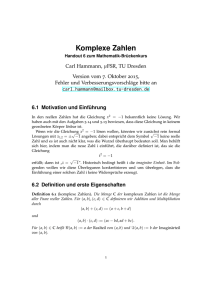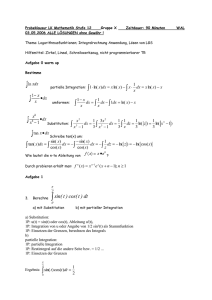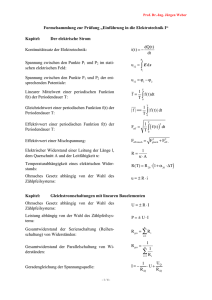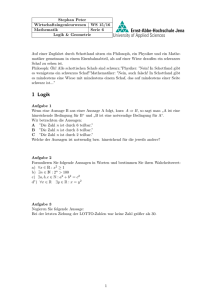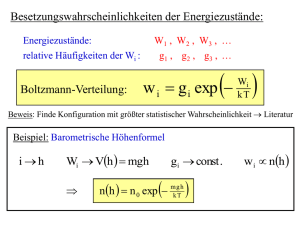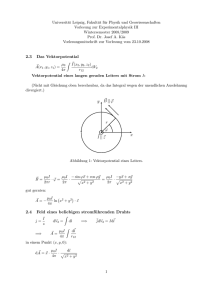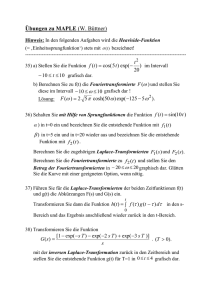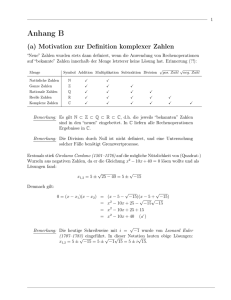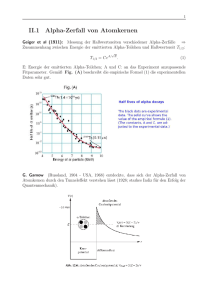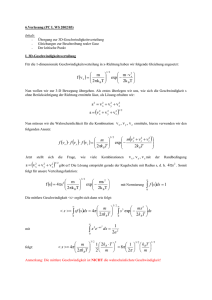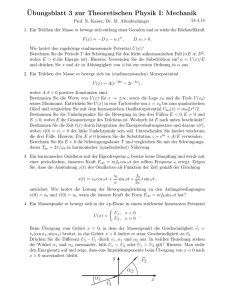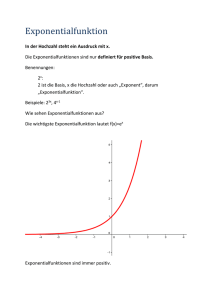Prof. Dr. Walter Arnold Lehrstuhl für Materialsimulation Universität
Werbung
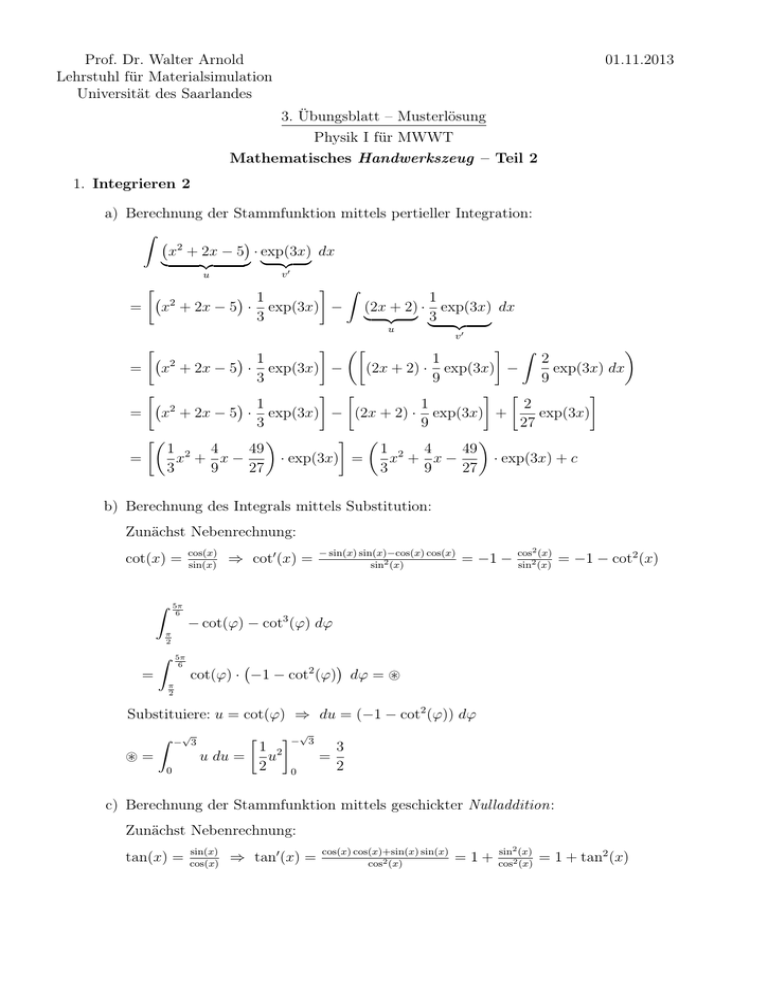
Prof. Dr. Walter Arnold
Lehrstuhl für Materialsimulation
Universität des Saarlandes
01.11.2013
3. Übungsblatt – Musterlösung
Physik I für MWWT
Mathematisches Handwerkszeug – Teil 2
1. Integrieren 2
a) Berechnung der Stammfunktion mittels pertieller Integration:
Z
x2 + 2x − 5 · exp(3x) dx
|
{z
} | {z }
v0
u
=
Z
1
1
x + 2x − 5 · exp(3x) − (2x + 2) · exp(3x) dx
| {z } |3 {z }
3
2
u
v0
Z
1
2
1
2
exp(3x) dx
= x + 2x − 5 · exp(3x) − (2x + 2) · exp(3x) −
3
9
9
1
2
1
2
exp(3x)
= x + 2x − 5 · exp(3x) − (2x + 2) · exp(3x) +
3
9
27
1 2 4
49
1 2 4
49
=
x + x−
x + x−
· exp(3x) =
· exp(3x) + c
3
9
27
3
9
27
b) Berechnung des Integrals mittels Substitution:
Zunächst Nebenrechnung:
cot(x) =
5π
6
Z
cos(x)
sin(x)
⇒ cot0 (x) =
− sin(x) sin(x)−cos(x) cos(x)
sin2 (x)
= −1 −
cos2 (x)
sin2 (x)
= −1 − cot2 (x)
− cot(ϕ) − cot3 (ϕ) dϕ
π
2
5π
6
Z
=
π
2
cot(ϕ) · −1 − cot2 (ϕ) dϕ = ~
Substituiere: u = cot(ϕ) ⇒ du = (−1 − cot2 (ϕ)) dϕ
Z
√
− 3
~=
u du =
0
1 2
u
2
−√3
=
0
3
2
c) Berechnung der Stammfunktion mittels geschickter Nulladdition:
Zunächst Nebenrechnung:
tan(x) =
sin(x)
cos(x)
⇒ tan0 (x) =
cos(x) cos(x)+sin(x) sin(x)
cos2 (x)
=1+
sin2 (x)
cos2 (x)
= 1 + tan2 (x)
Z
Z
2
tan (x) dx =
2
Z
−1 + 1 + tan (x) dx =
| {z }
Z
−1 dx +
+0
1 + tan2 (x) dx
{z
}
|
tan0 (x)
= [−x] + [tan(x)] = [tan(x) − x] = tan(x) − x + c
d) Berechnung des Integrals mittels Partialbruchzerlegung:
Bestimme zunächst Partialbruchzerlegung von
4
:
t2 +2t−3
4
4
A
B
A(t + 3) + B(t − 1)
=
=
+
=
t2 + 2t − 3
(t − 1)(t + 3)
t−1 t+3
t2 + 2t − 3
!
⇒ A(t + 3) + B(t − 1) = t(A + B) + 3A − B = 4 ∀t ∈ R
!
!
⇒ A + B = 0 ⇒ B = −A ⇒ 3A + A = 4A = 4 ⇒ A = 1 ⇒ B = −1
⇒
t2
4
1
1
=
−
+ 2t − 3
t−1 t+3
Z 0
Z 0
h
i0
h
i0
1
1
4
dt
=
dt
−
dt
=
ln
(|t
−
1|)
−
ln
(|t
+
3|)
2
−2
−2
−2 t − 1
−2 t + 3
−2 t + 2t − 3
t − 1 0
1
= ln = ln
− ln(3) = −2 ln(3) ≈ −2,197
t+3
3
−2
Z
0
2. Komplexe Zahlen 2
a)
x2 − 6x + 13 = 0
x2 − 6x = −13
(x − 3)2 = −4
√
x − 3 = ± −4
| − 13
|+9
√
|
|+3
x = 3 ± 2i
b) Die Gaußsche Zahlenebene, in der die komplexen Zahlen betrachtet werden, ist im Prinzip vergleichbar mit einem 2-dimensionalen, kartesischen Koordinatensystem. Dabei entspricht die reelle Achse der x-Achse, die imaginäre Achse der y-Achse. Die Zahl 3 + i
würde in diesem Fall danndurch
einen Punkt in der Zahlenebene repräsentiert, der die
3
kartesischen Koordinaten
hat, sich also 3 Längeneinheiten in positiver x-Richtung
1
und 1 Längeneinheit in positiver y-Richtung von Ursprung entfernt im 2-dimensionalen,
kartesischen Koordinatensystem befindet.
Die Differenz von 2 komplexen Zahlen entspricht dann dem Verbindungsvektor, der Abstand dessen Länge. Als Betrag einer komplexen Zahl definiert man den Abstand der Zahl
von der 0 bzw. vom Koordinatenursprung. Liegt die Zahl in der Form z = a + bi mit
a, b ∈ R vor, so lässt sich der Betrag mit Hilfe des Satzes des Pythagoras berechnen:
√
|z| = a2 + b2
Dabei bezeichnet man a als Realteil <(z), b als Imaginärteil =(z) der komplexen Zahl
z. Führt man die zu z komplex konjugierte Zahl z = a − bi ein, so lässt sich der Betrag
auch damit berechnen:
|z|2 = zz
Für Zahlen, die nun die Form z = exp(it) = cos(t) +i · sin(t) haben, ergibt sich wegen
| {z }
| {z }
a
b
cos2 (t) + sin2 (t) = 1 der Betrag 1, d.h. diese Zahlen liegen auf dem Einheitskreis in der
Zahlenebene. Über die geometrische Definition von Sinus und Kosinus ist ersichtlich, dass
der Ortsvektor der Zahl z = exp(it) mit der positiven reellen Achse den Winkel t (im
Bogenmaß) einschließt. Wenn der Winkel t nun von 0 bis 2π läuft, wird also der ganze
Einheitskreis abgedeckt. Darüber hinaus bietet es sich mit dieser Darstellung auch an,
eine komplexe Zahl mit Hilfe dieses eingeschlossenen Winkels (Argument der komplexen Zahl arg(z)) und ihres Betrages anzugeben: z = r · ei·ϕ mit r = |z|, ϕ = arg(z)
(Polardarstellung).
3. Partielle Differentiation
Gegeben sei die Funktion f (x, y, z) = x2 + 2yz 3 .
a)
∂f
= 2x
∂x
∂f
= 2z 3
∂y
∂f
= 6yz 2
∂z
b)
∂ 2f
=2
∂x2
∂ 2f
=0
∂y 2
∂ 2f
= 12yz
∂z 2
4. Differentialoperatoren
a) f (x, y, z) = cos(x + y) · exp(−z 2 )
∂f
= − sin(x + y) · exp(−z 2 )
∂x
∂f
= − sin(x + y) · exp(−z 2 )
∂y
∂f
= −2z cos(x + y) · exp(−z 2 )
∂z
sin(x + y)
~ = − sin(x + y) · exp(−z 2 )
grad f = ∇f
2z cos(x + y)
x
2
2
2
x +y +z
x
F0
y
~
b) F (x, y, z) = 2
· y = F0 · x2 +y2 +z2
2
2
x +y +z
z
z
x2 +y 2 +z 2
i)
∂
x
2
2
2
x +y +z
∂x
∂
y
~
~
~
div F = ∇ · F = F0 · ∂y · x2 +y2 +z2
z
x2 +y 2 +z 2
∂
∂z
∂
x
y
z
∂
∂
= F0 ·
+
+
∂x x2 + y 2 + z 2 ∂y x2 + y 2 + z 2 ∂z x2 + y 2 + z 2
−x2 + y 2 + z 2
x2 − y 2 + z 2
x2 + y 2 − z 2
= F0 ·
+
+
(x2 + y 2 + z 2 )2 (x2 + y 2 + z 2 )2 (x2 + y 2 + z 2 )2
x2 + y 2 + z 2
F0
= F0 · 2
= 2
2
2
2
(x + y + z )
x + y2 + z2
ii)
~ × F~ = F0 ·
rot F~ = ∇
∂x
∂
∂y
∂
∂z
−2yz
(x2 +y 2 +z 2 )2
−2xz
= F0 ·
(x2 +y2 +z2 )2
−2xy
(x2 +y 2 +z 2 )2
−
∂
×
x
x2 +y 2 +z 2
2 y2 2
x
+y
+z
z
x2 +y 2 +z 2
−2yz
= F0 ·
∂
z
∂y x2 +y 2 +z 2
∂
2 x2 2
∂z x +y +z
y
∂
∂x x2 +y 2 +z 2
−
−
−
y
∂
∂z x2 +y 2 +z 2
∂
z
∂x x2 +y 2 +z 2
∂
x
∂y x2 +y 2 +z 2
0
−2xz
− (x2 +y
0 = ~0
=
F
·
2 +z 2 )2
0
−2xy
0
− (x2 +y
2 +z 2 )2
(x2 +y 2 +z 2 )2
Merke: Die Rotation eines radialsymmetrischen Feldes verschwindet.
∂ ∂f
∂x
∂x
∂f ∂ 2 f
∂ 2f
∂ 2f
∂
~
~
~ 2f
c) ∆f := div (grad f ) = ∇ · ∇f = ∂y · ∂y =
+ 2 + 2 =∇
2
∂x
∂y
∂z
∂
∂z
∆=
∂2
∂2
∂2
+
+
∂x2 ∂y 2 ∂z 2
∂f
∂z
